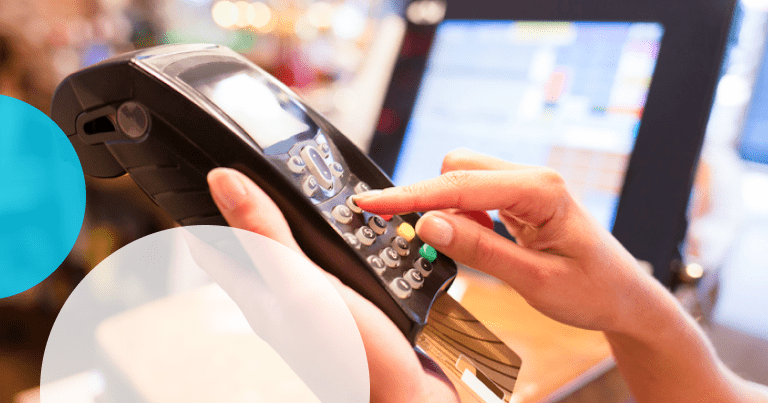Integrating your point of sale (POS) system with your website was once important, now it is increasingly becoming essential.
eCommerce is growing rapidly, so too are customer expectations. In a short space of time, the eCommerce website has gone from being an optional add-on to a central component of any retail system.
In this new environment, keeping your physical store’s existing POS and eCommerce website separate no longer makes sense. A siloed payments infrastructure creates fractured and inconsistent customer experience as well as complicating data collection.
In this article we will look at how to integrate a POS system with your website. But before we do this, let’s look at what POS integration is and why you should do it.
What is a POS system?
A point of service (POS) system (sometimes called a point of service or a point of purchase system) is the in-store technology used to accept and process payments, record purchases, collect customer data, and issue invoices and/or receipts.
A typical POS system in a retail business consists of:
- A screen
- A barcode scanner
- A card processor
- A receipt printing machine
- Software for recording purchases
POS systems vary in functionality. Many, for example, are also able to:
- Register discount and loyalty points
- Automate stock orders
- Issue and redeem gift cards
- Process returns and refunds
- Manage staff hours, etc.
An eCommerce POS system is the digital equivalent of a traditional POS. These systems are usually cloud-based and handle eCommerce sales using an online “shopping cart” and payment form to complete the transaction. It is integrated within the eCommerce platform and is usually able to provide analytics.
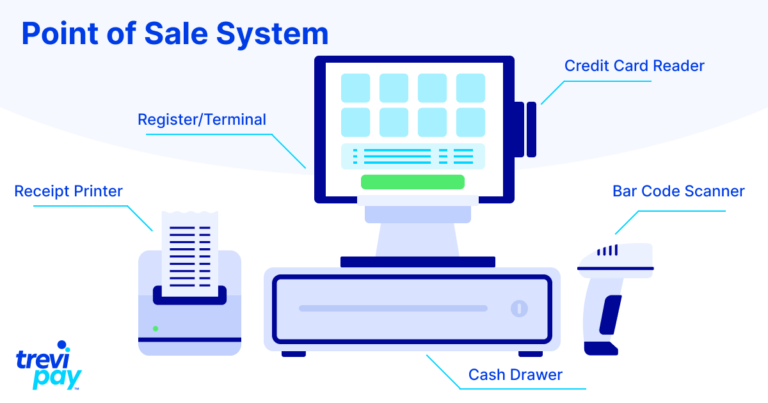
What is eCommerce POS integration?
An eCommerce POS integration means your brick and mortar and online stores’ Point of sale systems are synchronised by a separate platform or plug-in.
When it works well, it enables retailers to seamlessly coordinate between the online and offline side of their business. It enables third party apps to communicate in real-time and combine unified data from across all platforms.
This means you can update and optimise prices, inventory, promotions, delivery capabilities and more.
There are different levels of integration. Simply being able to send sales data between components isn’t always sufficient. You might also want to track inventory, export sales times, losses, credit card processing details, and other information.
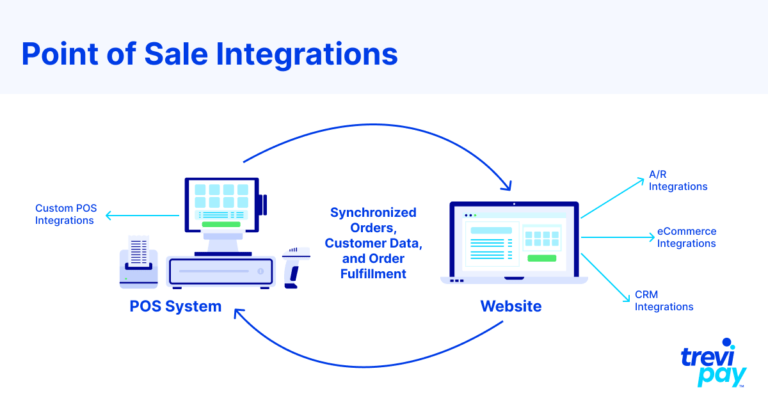
Why not just switch to one POS provider?
On the surface, switching to one POS provider for both sales channels can simplify your work process.
However, it can often lead to businesses being forced to discontinue use of particular apps that become incompatible with their new stand-alone POS system.
There is no one-size-fits-all POS solution for every aspect of any given B2B business’ complex payment needs.
If you want to continue using and experimenting with best-of-breed apps to hone your payments strategy (for a particular accounting software, for example), then integration is the way forward.
Why are online sales and physical stores sometimes kept separate?
Historically, many retail businesses have begun as a brick-and-mortar business. For many, the growth of online shopping in recent years has motivated them to add websites and eCommerce solutions later – almost as an afterthought.
This process can of course happen the other way round: an eCommerce platform specialising in online sales decides to open a traditional retail business – think Amazon!
For some, having a store and then opening a separate eCommerce business (with a separate eCommerce POS) is a rational progression. They can focus on their brick-and-mortar store and sell online to compliment it.
Some even manage both channels with separate teams: an in-store team and a specialist eCommerce site team. Orchestrating payment processes across these channels can reduce inconsistencies and enhance the overall customer experience, ensuring that both online and offline transactions are handled seamlessly.
Disadvantages of looking at in store and eCommerce as separate
Managing separate sales channels and teams simultaneously becomes difficult at scale. The internet has changed our shopping habits, and these different channels have swiftly evolved, as has the relationship between them.
After all, these different sides of the business are relying on the same inventory. Communicating information between the two channels on sale data, stockists, customer data and promotions can create problems for retail management operations.
This can cause frustration for customers and even between employees:
- It could lead to inaccurate inventory tracking, causing customers frustration for cancelled items
- Employees from different teams may have conflicting needs for particular products at specific times
5 Benefits of eCommerce POS integration
Worldwide, eCommerce sales are projected to grow to 5.4 trillion dollars (USD) (approximately 4.07 trillion GBP) in 2022. This represents a growth of 1.2 trillion dollars since 2020!
Furthermore, a study by Harvard Business Review found that research on a retailer’s website actually increased customer spend in store as well:
“Surprisingly, conducting prior online research on the retailer’s own site or sites of other retailers led to 13% greater in-store spending among omnichannel shoppers. This finding goes against the grain of the conventional wisdom that spur-of-the-moment, impulsive shopping bulks up the topline of traditional retailers.”
So the immediate financial value of opening an eCommerce platform is clear. Now, let’s take a deeper look at less immediately obvious benefits POS eCommerce integration brings to your business.
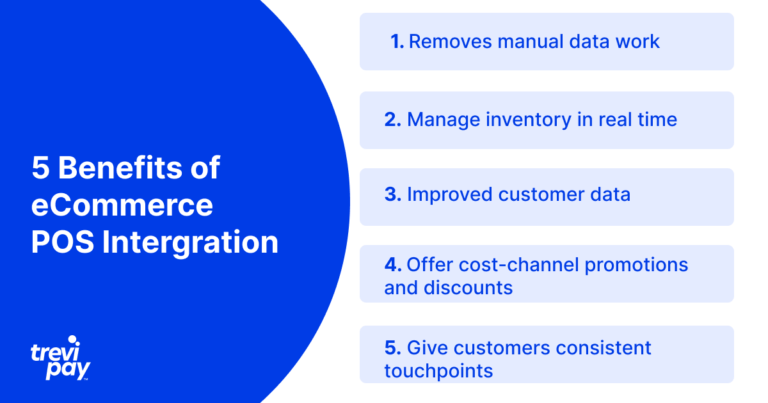
1. Removes manual data work
Separating your brick-and-mortar store from your existing website requires syncing different sales channels and POS systems, often via manual data entry. This takes up time and effort and creates potential for human error.
It requires a longer employee onboarding process with different POS systems to learn to operate.
Potential human errors due to data entry can cause frustration for your customers; leading to incorrect invoices, inventory issues and friction during the onboarding and reconciliation processes.
With the right integrated POS solution, your online and offline sales channels will be automatically synchronised. You will no longer have to reconcile data reporting between your physical store and eCommerce platforms. And your employees can be onboarded more efficiently.
2. Manage inventory in real time
Retail stores and eCommerce businesses’ customer activity can be influenced by different factors, such as the recent surge in online sales exacerbated by the pandemic. This adds a layer of complication to inventory management.
Being able to monitor your stock in real-time enables you to anticipate surges in online ordering or footfall to brick-and-mortar stores. This helps you to avoid selling out or overstocking items, better managing your capital and meeting customer expectations.
Automated processes ensure timely replenishment of inventories in multiple stores or fulfilment centres. This makes offering increasingly essential customer offerings like click and collect or buy online pickup in store (BOPIS) significantly easier.
In short, it helps you efficiently handle your inventory management. You can avoid unnecessary out-of-stock scenarios which damage your customer loyalty and gain the flexibility and foresight to offer more customised shopping options.
3. Improved customer data
If your POS and eCommerce site isn’t integrated, you will have to reconcile the data records and analysis you do have, manually. This can be time-consuming and increase the likelihood of errors during the replication process.
With successful eCommerce POS integration, this work is automated and data can be viewed holistically. As a result, you can gain a more comprehensive and insightful view of offline and online customers behaviour and when it overlaps through enhanced analytics capabilities.
Unifying your POS systems also helps prevent fraud, which can take place when confusion between in store systems and online store systems is exploited by bad actors.
4. Offer cross-channel promotions and discounts
Nowadays, customers like to look at and buy products both online and offline and expect the same seamless experience, regardless of channel.
Managing your sales across both platforms makes it easier to be consistent with promotional offers and discounts.
It improves options for how customers can engage with your loyalty programmes and your ability to notify them of special offers (with flash sales, for example).
You can also gain insight into the success of the promotion through analytics.
5. Give customers consistent touchpoints
In retail, a touchpoint is any time a customer (existing or potential) comes into contact or interacts with your business or brand. This can be in the form of ads, reviews, visits to your store or website, media mentions, etc.
As with point 4 about offering cross-channel promotions and discounts, keeping consistency in your payments process across online and offline channels is paramount.
Without POS system integration, inconsistencies in pricing, offers and stock availability can appear between your online store and brick and mortar stores. The possibility exists that one or both system fails to meet the complex payments needs of the buyer.
Such disconnects will cause mismatches between customers’ expectations and reality. It may be down to a lag (or error) in manual data entry, limited functionality or perhaps a different marketing approach.
Either way, it causes something every retail business wants to avoid: disappointed and frustrated shoppers.
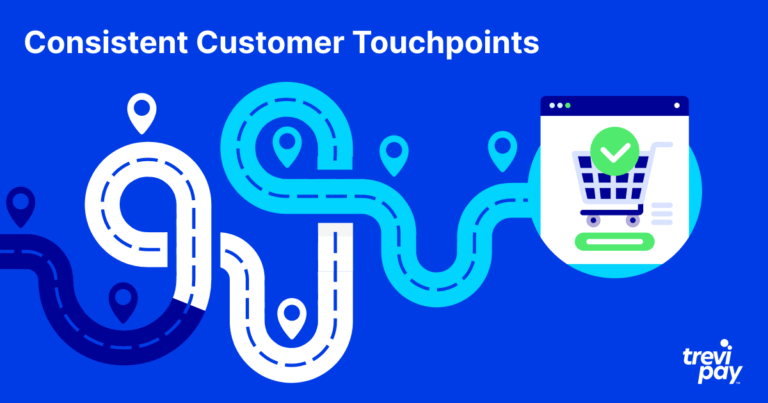
Summary: POS integration = better customer experience!
POS integration delivers clear efficiencies for your business operations. But all the points made in this article add up to one theme: creating an improved experience for customers!
Customer satisfaction lies at the heart of retail and eCommerce. And whatever way you look at it, eCommerce POS integration benefits customer experience in a number of ways:
- It frees up employees’ time. Staff can now focus on customer experience (both online and offline) rather than tasks like manual data input, managing inventory, keeping track of different promotions, or devising separate marketing campaigns.
- It gives you insights into your own inventory and customer’s habits. Without good-quality and unified data, maximizing customer experience across your online store and physical locations isn’t easy.
- It creates a consistent and seamless brand experience. Your online orders and offline channels should be a part of the same comprehensive branded experience. Your eCommerce platform is simply a separate part of your store, not an optional extra. Customers can explore both during their decision-making process – and not be confused by mixed messaging or pricing along the way.
Which POS system should you use?
Which POS system you choose depends on many things. Perhaps you have an existing POS system and eCommerce software that you want to work with. Or maybe you are starting from scratch.
Either way, you should first consider your options. Reviews in industry publications and websites like Trustpilot are a good place to begin, but don’t underestimate the value of speaking to other business owners.
There are a number established POS system providers to explore, including:
- Square
- Vend
- Bingo POS
- Intuit QuickBooks
- Erply
- Shopify POS
Your industry could also affect your decision. Food suppliers, for example, often choose specialized platforms, like Local Line.
If you work in B2B, then our solution could well be one for you. We offer distinctive B2B features that increase customer satisfaction and AOV, such as allowing B2B buyers to pay by invoice and request trade credit of up to $250,000 (£187,000 approx), deliver automated credit decisioning in as little as 30-seconds, and effortlessly approves credit applications and purchases in the very same session.
Our solution also provides eCommerce integration for platforms like Magneto, BigCommerce, GenAlpha, Elastic Path and more.
3 factors to consider when choosing a POS system
Besides recommendations and industry specialism, let’s look at three key factors you should think about when considering your POS eCommerce integration.
1. Compatibility
You will need to consider where your online store is hosted and what compatibilities it has available.
POS integrations have evolved alongside digital commerce, and there are multiple solutions for POS and eCommerce platforms. However, before you commit, you need to be sure of the compatibility of your chosen providers with other software important to your operations.
Of course, depending on your current POS and eCommerce site, you can always consider switching providers or consolidating functions from other software, as a place to start.
2. Cost
The cost of each POS system can vary according to the hardware and software options they offer.
POS hardware is made up of a number of components, including cash drawer, barcode scanner, card readers, receipt printers, touchscreens, etc.
The total upfront cost of all of these parts together can range anywhere from between $400 to $7,000 (£300 – £5,000 ), though this cost obviously increases if you are ordering for multiple locations.
POS software can also be bought outright or rented. This can range from being completely free to upwards of $1,100 (£800) to buy outright, or $35 – $40 (£20 to £35) per month to rent. Suppliers often offer a range of customisable package deals.
There are also payment processing fees to consider. Different providers have different rates. And think carefully about the contract terms before you sign up to a service – make sure they support your future plans.
3. Aesthetics
The look and feel of a POS system will obviously influence a brick-and -mortar shops’ image.
Likewise, the functionality and appearance of the eCommerce shopping cart and payment terminal for online orders will also influence customers’ experience online.
A poor customer experience could lead to lower sales, or even drive them to a competitor.
You should research how customisable different provider’s technology is, both for the in-store POS system and on your eCommerce site. Does it provide the type of experience you want for your customers?
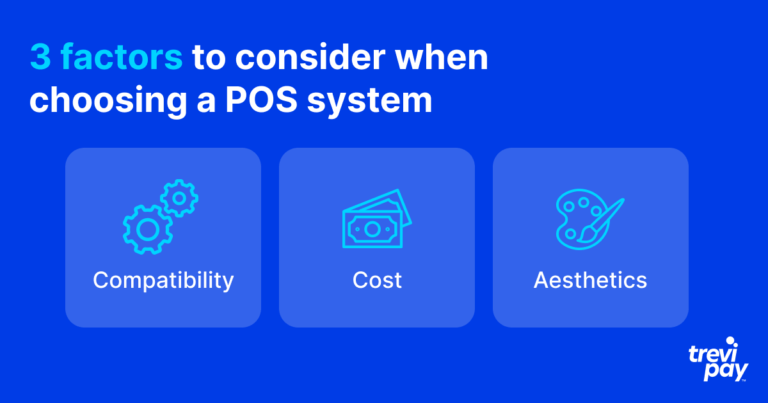
How to integrate POS with a website
The specifics of integrating POS software with your website depends on several factors, primarily on which provider you choose.
For larger integrations, this is often done with the help of a development team. Different providers offer different levels of support for this transition.
The majority of the work in this process takes place at the beginning. Selecting and then implementing your chosen integration will require much more work than the day-to-day running of it.
The pay-off is that once complete, your business will reap the range of benefits that come with integration.
Before we look at the process of integration more closely, let’s explore some important points around the first and most important decision…
6 steps for integrating POS with your website
Below are some important points for you to bear in mind if you want to achieve a successful POS integration with your website.
1. Data transfer
If you are switching providers rather than upgrading an existing one, transferring data from your existing retail POS and/or eCommerce store will be a logical first step.
Make sure you have granted access to the relevant parties to your new system and set up all necessary notifications.
This might be also an opportunity to check if your eCommerce platform and retail business are using unified SKU codes and that everything is lined up with your accounting software’s reporting.
Your unified store and customer data is then able to be passed back and forth between systems.
Depending on the scale of the solution being implemented, businesses can expect an integration to take anywhere from an hour to several months to accomplish.
2. Web images and product description
Depending on what system you are currently working with, you may need to re-catalogue your existing inventory.
Be sure to update and monitor your product listings within the framework suggested by your eCommerce solution.
This means paying attention to suggested image (file size, type and dimensions) and word count specifications, as well as consistent product naming and tagging schemes.
3. Webpage speed
Nothing puts off users more than a slow eCommerce store. If your product pages don’t have a Largest Contentful Paint (LCP) of under 2.5 seconds, you could be losing a significant percentage of business.
Image sizes and file types can also impact this a lot. Or it might be a deeper issue with your site’s server hosting provider or webpage’s code.
Work with a web developer to make sure your pages load quickly and smoothly for all users.
4. Sales reporting
Your newly integrated POS system will generate a POS report that covers both retail store and eCommerce store.
Take note to understand how this works and where it differs from your current POS system. Review this data often, it provides insights into customer behavior, and can even help you better understand your cash flow management and align business strategies.
Inside your organization, onboarding staff early in the process is obviously a must. The more training they get the better you will be able to take advantage of the full functionality of the integration.
5. Email marketing integration
You might even be able to integrate your current email marketing system with your POS system. Many retail POS systems also now come with inbuilt email marketing function.
As mentioned above, this ability also provides consistency between your ability to easily send and track promotions and discounts to your customers.
The new cross channel analytics you gain will no doubt help improve the quality of your email marketing abilities, as well.
6. Schedule regular online store inspections
Once your eCommerce POS integration is complete you should regularly look at it through your customers’ eyes.
This is not just for monitoring potential errors, but also with a view to seeing if any general user experience improvements can be made. In fact, a recent study of B2B buyers found that 74% of B2B buyers would make a purchase with a competitor if their vendor’s eCommerce store could not keep up with their purchasing expectations as a buyer
On the ground, you will hopefully get immediate and accurate feedback from how the retail POS side is running from your in-store employees.
Remember to check that updates to inventory occur across all apps in your sales ecosystem. Some integration software takes care of this for you, but others leave it to the user.

Conclusion
Businesses now need to look at their physical store and online channels as part of the same retail system.
Integrating your POS system with your website is a crucial step towards achieving this.
Integration will bring multiple benefits to both your store and eCommerce operations. Ultimately, in-store and eCommerce POS integration will provide clear, consistent touchpoints and buyer journeys that will improve customer experience.
It will also enable you to significantly improve your marketing and inventory management capabilities.
If customers can’t purchase directly and smoothly from your online store, you could be throwing away eCommerce sales. It’s just like turning away customers away from your physical stores.
POS integration will require work in the short term. Finding the right integrated solution for your business isn’t always straightforward. However, once completed, it will save you time in the long term by reducing admin.
Once you have covered these aspects outlined in the article above, the eCommerce component of your business will be firing in time and on all cylinders with the rest of your business.
You can then spend less time reconciling data and more time utilising it to drive innovation and increase sales.

